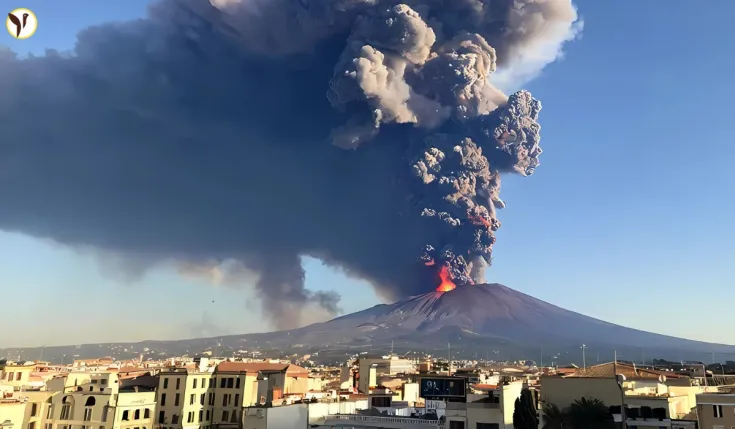Mount Etna, the tallest and most active volcano in Europe, erupted dramatically on the morning of June 2, 2025, blanketing the Sicilian sky with thick ash clouds and bright embers. This most recent eruption of the most famous volcano has captivated scientists, tourists, and locals as well as initiated a broad range of emergency responses.
In this post we will cover everything you should know about the Mount Etna eruption of 2025 - from the eruption, to the amazing visuals, response measures, and finally what it means for the Mt. Etna region.
The Eruption Begins
The strumming sound of a warning alarm bell, or perhaps the tickling sound of a geologist's wet dream, began to be heard in the evening hours of June 1, when seismic tremors around Mount Etna began to ring out. According to the Italian National Institute of Geophysics and Volcanology (INGV) reports of volcanic activity around 10 PM local time began to accelerate. Tremors escalated rapidly, and before we knew it, early morning glances at Mount Etna no longer revealed a slumbering giant.
The eruption began with a huge ash cloud that stretched almost 6,400 meters (21,000 feet) stirred into the sky. An ash cloud of this magnitude prompted the Volcanic Ash Advisory Centre (VAAC) in Toulouse to issue a "code red" aviation warning. This massive start to the eruption was only a preview for the level of eruptive activity that would surge to follow.
Massive Ash Clouds and Lava Fountains
Perhaps the most visually striking aspect of the Mount Etna eruption was the formation of massive ash clouds that spread throughout the Sicilian region. The volcanic plume not only disrupted air travel but also deposited fine volcanic particles onto communities within the surrounding area and advised people to limit outdoors activities to avoid inhaling the ash.
The eruption was further enhanced by the collapse of the southeast crater, creating explosive lava fountains, sending fiery jets of molten rock down the mountain's slope that were seen from miles away.
Lava flows were detected traveling down Etna's slopes using infrared satellite imaging, while pyroclastic flows were more evident in video footage from local surveillance cameras. The eruption most intense event occurred just after 11:30 AM local time, with heavy activity concentrated at the southwestern part of the volcano.
Social Media
During the eruption of Mount Etna, social media provided real-time updates. Tourists and locals posted dramatic images and videos of ash-filled clouds being ejected into the atmosphere, lava fountains that lit the sky, and a number of were posted that showed visitors fleeing the site and escaping the ash plumes which engulfed the area.
One particularly remarkable video posted by tourists near the Rifugio Sapienza that evening was an opera of surreal beauty in the eruption of Mount Etna; orange molten lava in stark contrast to the black, ashen sky. The videos allowed a global audience to view its eruption and developed a greater appreciation for one of the most active volcanoes in Europe.
Flight Disruptions and Safety Warnings
The immediate impact of the eruption was also seen in the skies. Flights at Catania Airport, located just 50 kilometers (31 miles) to the south of Mount Etna, experienced significant delays. Ash clouds over the airport posed a serious risk for air travel, as aircraft engines can be severely damaged by volcanic ash while also producing low visibility conditions for operations. Airlines acted quickly to protect passengers by rerouting flights, notifying passengers of delays, and postponing further flights.
Although the initial "code red" warning level by the VAAC resulted in cancellations, conditions improved over time. By midday, the alert was downgraded to "orange," and aviation authorities were able to start finding means of safely reopening airspace as volcanic ash clouds began drifting to the southwest.
On the ground, Sicilian authorities were focused on public safety and making sure evacuations of tourists and hikers would take place in the affected areas. Local emergency plans to respond to an eruption was activated which limited any disruption for residents of the impacted areas.
The Science of Mount Etna's Activity
Volcanologists have a keen interest in Mount Etna, which, at 3,329 meters (10,922 feet), is both one of the most studied and understood volcanoes in the world and clearly also one of the least understood . The unpredictability of its eruptions remains difficult for scientists to address.
Volcanic eruptions like that of Mount Etna are caused by the movement of magma inside of the Earth's crust. Mount Etna is located on the volcanically active plate boundary between the Eurasian and African plates. Movement of magma inside the Earth crust is something that occurs with frequency; eruptions serve as a reminder of the dynamic processes occurring beneath us that inspire both wonder and precaution.
A Glance Ahead
As the eruption highlighted significant disruption, authorities and experts have been enthusiastic about the emergency services and the local agencies' prompter responses. Their strong coordination facilitated the lack of lives lost from the eruption's perspective, while air traffic control collectively reduced possible risks to aviation.
To Sicilians, Mount Etna remains a source of pride and a constant reminder of the unpredictability of nature. Regardless of if periods of activity occur (which does happen), eruptions such as that of June 2, 2025 reinforce the need for increased vigilance, both through scientists and communities.
Stay Updated on Mount Etna and Global Volcanic Activity
The eruption of Mount Etna once agin has added to its reputation as one of the world's most active and engaging volcanoes. If you are an explorer of natural phenomena, a potential visitor to Sicily, or someone who simply wants to keep informed, keeping track of Etna is often worth your time. Would you like to learn more about the major volcanic events’ science and implications? Follow our blog to stay updated!







